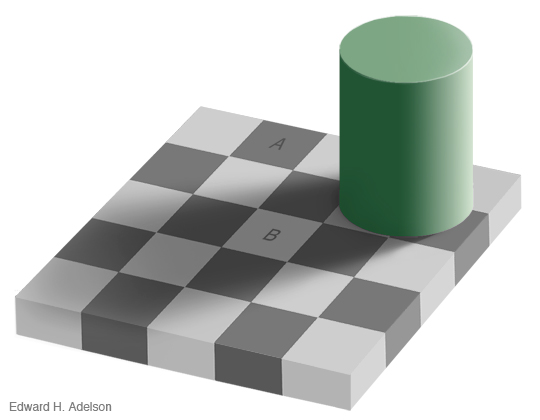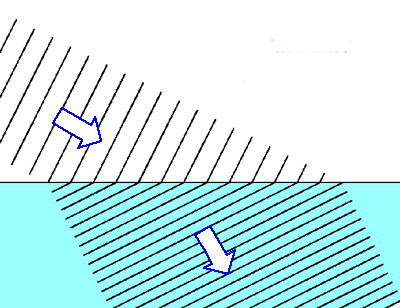 That black hole you were worrying about is only the dot above an ‘i’ on the page of the book we are about to hit.
That black hole you were worrying about is only the dot above an ‘i’ on the page of the book we are about to hit.
“So are we going to disappear?”
We haven’t finished our journey yet so I imagine not.
“OK, talk me through this one. Black means no light, therefore if we hit that dot we'll never be seen again. End of story.”
No, luckily for us black doesn’t mean no light at all. The letters on a page will always look black as long as there is a lot less light coming off the black letters than the white part of the page. It’s all about contrast, the difference between the brightest thing you can see and the darkest. This page will look much the same read at night by torchlight or in full sunlight even though sunlight might be a hundred thousand times brighter. There will be more light coming from the black letters in bright sunshine than is coming the white page by torchlight. So exactly the same amount of light can look white or black at different times. Sometimes the same amount of light can look a different colour at the same time.
“How can that make sense?”
Look at this picture. The two squares marked 'A' and 'B' are the same brightness. 
“No they’re not.”
'A' just looks darker because of the way we see contrast. Take a piece of paper and poke two holes so that you can only see the 'A' and 'B' but nothing else of the picture. You will be surprised to see two grey holes of the same colour and brightness.
"Whooaaaaaahhh! What just happened?"
Can I say I told you so?
“You can if you explain what just happened.”
We just bounced of that black dot and lived to tell the tale. The dot is black, so lots of photons were absorbed, but as I said even black things reflect some light and we were some of the lucky ones that made it.
"What happened to the ones that didn't make it?"
Well, they were absorbed by the black ink on that dot. They stopped being photons but they didn’t just vanish. They changed to a different form of energy, mostly heat. In sunlight the letters in an open book will be slightly hotter than the white page because the black ink will absorb more of the sun rays. It’s just the same as sitting in the sun yourself; you get hot because you are absorbing photons. Along with all the others laws that universe follows, there are laws of thermodynamics that explain how energy in the universe behaves. Light is a form of energy and so has to obey first law of thermodynamics. This law says that energy can change from one form to another but can’t disappear or be made.
“How about power stations they make power, isn’t that energy?”
A power station is a perfect example of this first law. Whatever type of power station you think of, they all just change some other form of energy into electricity. It could be wind powered, burning coals which like all the other types of fossil fuel is really stored sunlight from long dead plants, even directly solar powered. But every power station is converting energy not making it.
“OK Albert how abour your E=Mc2? Didn’t you say you can convert matter into energy? So how about nuclear power stations?”
Excellent, so you have been listening. That equation just means that matter is really a special type of energy. So a nuclear power station is a real world proof of Einstein’s equations and the first law of thermodynamics.
"What's going on now? I'm being bent. I've travelled in a straight line for hundreds of years from a distant star and in a few fractions of a second I’ve narrowly escaped dying and been twisted in a very unnatural angle and to top it all we just slowed down."
I think we've just been refracted. We just hit one of the lenses of a pair of glasses.
“Hang on, we can travel through thousands of billions of miles of space at highest speed the universe allows but we can be slowed down by a pair of glasses?”
I’m afraid so, that’s how glasses work. Glass is transparent so light travels through it easily enough, but only at about two thirds of our normal speed. So you see light doesn't always travel at the speed of light. The speed of light, the ‘c’ in E=Mc2, is more like a speed limit than a law.
“So what does refracted mean?”
When light hits something at an angle that it makes it go slower (or faster) it gets bent. That’s refraction.
“Is that the same type of bending of light that black holes or even stars do?”
No, refraction is quite different and I’m happy to say a lot easier to explain than relativity. Imagine a car, if you drive straight onto some surface that slowed you down like gravel you would still be going in a straight line, just slower. If you drove onto it at an angle then one front wheel, say the left, would hit it first and that side of the car would slow down. The other front wheel, the one on the right, would still be gripping the road and would keep going at the normal speed for a moment until it hit the slow stuff.
“What happens to the car?”
It gets pulled over to the left until all the wheels are in the slow stuff and then it goes in a straight line in a new direction but at a lower speed. That’s exactly how light gets bent by glasses.
“So how do glasses work?” Lenses in glasses are curved so that they can focus light. Hit a different part of the glass and light is bent a different direction. If you are long sighted your glasses will bend light rays inwards and if you are short sighted your glasses bend light rays outwards.
Lenses in glasses are curved so that they can focus light. Hit a different part of the glass and light is bent a different direction. If you are long sighted your glasses will bend light rays inwards and if you are short sighted your glasses bend light rays outwards.
“How does that help?”
The eye is like a camera and must bring rays of light to a single focus inside the eye. If the focusing isn’t quite right, then glasses can help the eye bring things into proper focus. If you are long sighted then the focussing power of your eyes isn’t strong enough to bring all the rays of light into focus. So glasses for long-sightedness do some of the bending for you. If you are short sighted the eye focuses light too much so by the time it reaches the back of the eye it is blurred. Glasses for short-sightedness bend light away from a focus point to counteract the effect of overly strong eyes. But now it is time to be refracted again, this time by going out the back of the lens and into air again.
"That's much better, almost back to our normal speed 'c'. By the way Albert, why is the speed of light called 'c' ?"
Nowadays people seem to that 'c' comes from the latin word celeritas which means swiftness, but in my day it was because it was a constant. If fact back in 1905, I wrote the equation that everyone now recognises as m = L / V2 because I used V for the speed of light and L for energy, it was a few years later that I re-wrote it as E=Mc2.
This is the story of a great journey that started with a great thought. One day in 1895 a boy looked into a mirror and wondered what the universe would look like if he could travel on a beam of light. That sixteen year old boy was Albert Einstein and that one thought started him on the road to discover his Theory of Relativity. The great man has been reinvented as Albert 2.0 to come back and blog about a journey through space on a beam of light and explain the science behind everything from atoms, blackholes to global warming. If you've just joined and want to start at the beginning use the index on the left. If you're bored try these links below just for fun.
UNSCRAMBLE EINSTEIN'S BRAIN
PRACTISE SAVING THE WORLD FROM ASTEROIDS
ALIEN CONTACT CALCULATOR
HEAR THE REAL EINSTEIN TALK ABOUT E=Mc2.
Friday, November 23, 2007
Black Holes and Grey Holes - All very strange.
Posted by albert2.0 6 comments
Labels: black hole, contrast, illusion, refraction
Subscribe to:
Posts (Atom)







